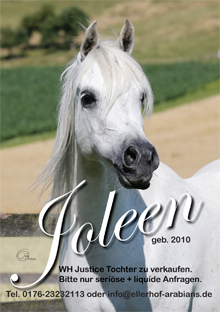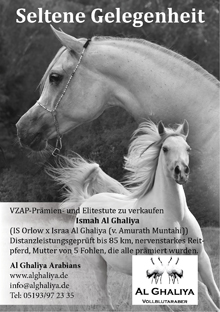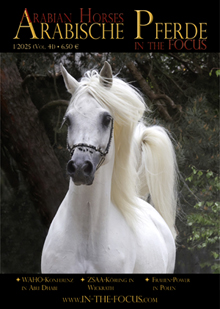You may not be aware of it, but 2023 marks an anniversary: 50 years ago, the first international Arabian horse show was held in Germany. Time to look back at those beginnings and to examine the developments and changes in the show scene during the past half century.
Of course, there was no such thing as a „show scene“ in 1973. The world was very different back then, including the world of Arabian horses – a world many of today’s Arabian breeders and owners have never known.
In the early 1970s, Arabian breeding in Germany was just getting properly started. Before that time, it was limited to Marbach and a bare handfull of private breeders, but during the 1970s, new studs farms were popping up all across the country. Many of those new breeders wanted to try something different and imported their foundation horses not only from Egypt, but from Poland, from Spain, and from other countries as well. Breeding in Germany became more colourful and more diverse. There was as little unity as there is today. The German Arab Horse Society, which was still its infancy, broke apart when a group of prominent breeders defected to found a rival registry, the „Arabian Studbook of Germany“. This included many big names of the foundation years: Dobimar von Kameke, Rolf Ismer, Carl-Heinz Dömken, Om El Arab, Günter Seidlitz and many others. Like it or not, this group of „rebels“ put out the best and most informative Arabian stud book that has ever been published in Germany.
It was this group which, in 1973, organised the first international show for Arabian horses at Verden, near Hanover. And everyone came: all the breeders of the „Studbook“, Marbach State Stud, exhibitors from Sweden, and the Polish state studs. The director of Janow Podlaski, Andrzej Krzysztalowicz, was one of the judges, along with Dr. Ameen Zaher from Egypt, Count Lewenhaupt from Schweden, and Ronald Kydd from the United Kingdom.
Here is an interesting quote from the preface to the show catalogue, written by the Studbook’s chairman Dobimar von Kameke: These championships for Arabian Horses are open to international competitors. This highlights the intention of the „Arabian Studbook of Germany“ to encourage a broad spectrum of competition, thus enabling the best possible demonstration of the desired type and conformation. This show is meant to provide directions for our breeders. For this reason, we have attempted to win experts from several countries as judges. Ridden competitions as well as displays under saddle show that Arabian horses have at all times served as riding horses and are bred exclusively for that purpose today. The beauty and elegance of this breed are not an end in itself, but closely linked to its desire to work with people and its trust in them.“ Many modern exhibitors should take that last sentence to heart!
International top horses
Not only the judges, but the equine competitors of that show read like a veritable who’s who of international Arabian breeding. Salon was there, the former chief sire of Tersk who, after being mostly ignored in Germany, had a late second career in the USA. Pohaniec from Sweden, whose son Probat was destined to leave his mark on Polish breeding. El Paso from Poland, who, a few years later, would be sold to the USA for a seven figure sum and become National Champion there. Kilimandscharo, whose offspring would be exported across the whole world. Shaker El Masri, whose son El Shaklan would become the first global sire, revolutionising Arabian breeding world-wide. And consider the variety, the diversity shown by just these five great stallions! You don’t see horses like this at the shows anymore; certainly not the first three, none of whom had the slightest hint of a „dish“. Kilimandscharo and Shaker El Masri did have it, but nothing remotely like the extremes the judges shower with „20s“ these days. Neither of them, as typey as they were, placed highly at Verden. The judges didn’t just look at the type, but also – and primarily – at the conformation.
Consequently, the title of Champion Stallion was given to a horse that combined both in an ideal manner: Marbach’s chief sire Saher (Ghazal / Sahmet). In his class, the second place was awarded to El Paso from Poland, who had flawless conformation as well, but a somewhat plain head. Another Polish horse, Pohaniec from Schweden, won his class and was named Reserve Champion. Second his his class stood yet another Polish stallion, Diem from the Ismer Stud. In this class, Salon was placed fifth, and Shaker El Masri seventh. And what about the mares? Even then, there was no getting past the Poles. The championship was awarded to the winner of the class for older mares, the lovely Nabor daughter Estebna from Michalow. Second in her class stood none other than the Spanish legend Estopa. The Reserve Champion title, however, was given to Marbach‘s Egyptian import Nadja. She was only sixth in her class, but she won the mare produce groups.
There were ridden classes as well, of course, and some of the in-hand competitors took part in them, including Saher and Salon. There was also the very first race for Arabian horses in Germany, in which, to everyone’s surprise, the Polish horses were beaten by the US-bred Babson-Davenport stallion El Beshir – something you’d never see happen today. Spectators flocked to this event just as the exhibitors did. The weather was clearly less than ideal, but people still crowded along the ringside, many of them armed with umbrellas.
1979 – Starting signal for Aachen
Verden was an isolated event at the time. Nothing more happened along those lines until 1978, when the WAHO conference was held at Hamburg and another international show was organised to complement the event. By this time, the two rival German registries had reunited to form the VZAP and published a new, WAHO-accepted stud book. Some of the horses that had been shown at Verden were also at Hamburg, including Kilimandscharo and Estopa, who won the stallion and mare championships, respectively.
In 1979, the VZAP hosted an international show at Aachen, the first of what was to become an annual event. During the first few years, it was not much different from Verden in 1973. Nearly all German breeders and horses of note were present, whether purebred, Shagya-Arabian, or Anglo. As in Verden, the horses were shown by their owners, presented naturally, and judged by expert horseman, who were not necessarily associated with Arabians. Not everyone agreed with that. In his show report in the magazine Arabische Pferde, Dr. Saenger complained about the Crabbet stallion Al Malik from Britain being chosen as Champion instead of the more refined Kaisoon son Koran from Germany. But in the end, it’s a matter of taste. Al Malik may have been a bit too fat, but that didn’t make him the inferior horse. Needless to add, neither of these two stallions would stand the ghost of a chance at a modern show.
Aachen had not only well-filled classes, but equally well-filled grandstands. Everyone in Germany who had any interest in Arabian horses (and they were getting more each day) came to Aachen. It was an event not to be missed. If you look at photos from Aachen not only from that first year, but throughout the 1980s and much of the 1990s, you see packed grandstands and, while the show as still held outside, crowded ringsides.
For those who experienced that time at Aachen, it was truly a Golden Age. Yes, even though in the early 1980s, American show practices began to creep into the formerly rather sedate German shows. Suddenly the handlers started to perform strange gymnastics in front of the horses, to get them to stretch their necks up high. For a stallion like Plakat, who was champion at Aachen more than once, this was certainly an advantage, since a short neck was this stallion’s greatest weakness, excellent though he was in every other respect. No one is likely to forget the first appearance of the „flying Dutchman“ Jan Calis, who could run like no other, whooping loudly as he went. Aachen was the birthplace of many stars of the scene. Besides Plakat and Jan Calis, one of them was Mansul, the striking copper chestnut stallion from Germany‘s Saalegrund Stud, who announced his presence with his trademark lion’s roar long before you could see him. Or his near-black half brother Wisznu Ibn Sawih, who on one memorable occasion tore loose during the prizegiving ceremony and chased the unfortnate pony that carried the ribbons all around the arena. Nor will anyone forget the wonderful ridden displays with Jutta Hell’s two purebred stallions, Achmed and Sascha, who were highly schooled dressage horses. There were ridden competions during the early years, too, even driving displays with Arabians in harness during the early 1980s. Other highlights of those early years included the rare public appearances of the Nazeer son Kaisoon, the most used sire in Germany, with some of his offspring, or the return of the Poles to Aachen in 1983 with their wonderful mares. Ten years after Verden, Andrzej Krzysztalowicz accepted the championship trophy at Aachen for his beautiful mare Candela. One year later, Poland secured the All Nations Cup with its splendid mare collection – not for the last time. Within a few years, the ancient imperial city in Germany became the centre of the Arabian breeding world every last weekend in September. Aachen had become the one event nobody wanted to miss.
And 50 years later?
So what’s it like now, 50 years after those first beginnings at Verden? In late September 2023, Aachen is still the centre of the Arabian breeding and showing world. But it is a very different world today.
Where once you had to get up very early if you wanted to secure a seat on the grandstand, it doesn’t take much of an effort now. Vacant seats are always available, even entire vacant rows. The only well-filled seats are just behind the judges and in the VIP areas, which have taken up an increasing amount of space over the years. They can’t get any bigger now, because there is little enough room left for what should be the main thing: the presentation of the horses. Where in the 1990s, stallions like Plakat, Vodolej, or Kubinec could trot one wide round after another, cheered on enthusiastically by the crowded spectators, they would hardly be able to do so under today’s constrained conditions. In fact, you rarely see a „moving machine“ like those three stallions today, or even a horse that manages to trot the length of the ring, never mind a full round. Is this because they can’t do it, or because they are not allowed to? Instead, they are circled in each corner while additional „helpers“ do their utmost to distract the horses from actually trotting. You might think that some horses are deliberately kept from trotting more than a few paces, because if they did, it might become only too obvious that they don’t have the ability of a Plakat or a Kubinec.
You might argue whether the dwindling audience is caused by the way of showing the horses, or by the horses themselves. There are certainly several factors involved. The presentation of the horses has in fact changed in a way that real horsemen find almost impossible to watch. It is bad enough the the horses are posed in front of the judges in an unnatural, frozen stance, even without some of them only too obviously showing their fear of their handelrs. In addition, the stretched-out pose makes any real evaluation of a horse’s conformation impossible. As a result, the marks given by the judges have no value other than helping them with the placing. The leg marks in particular have no significance at all. If you actually analyse the leg marks, you find that each horse ends up with the same average score for legs, no matter how good or bad they really are. The placing is decided mostly by the scores given for type and for head and neck, where unfortunately the most extreme specimens get the highest scores. An excellent individual with a straight head, like El Paso or Pohaniec, could never win a class today, never mind a championship.
The horses themselves may well be another reason for the lack of interest. The wonderful diversity on display during the early years is gone today. Thanks to globalisation and the progess made in the reproductive technologies, breeders all across the world are using the same bloodlines today and, if they want to show, try to achive the same „ideal“ type. As a result, you see mainly one particular type of horse at the shows today, with a clearly (sometimes exaggeratedly) dished profile, a long neck, a straight opline, and overly fine legs. Any remnants of individual expression are smothered beneath layers of grease and blackening. If you consult the catalogue, you will find the same bloodlines in all horses, no matter which country they come from. Even the Poles are no longer exempt.
Today’s shows are no longer a means of evaluating potential breeding stock, not even a friendly competition between fellow breeders. They are a tough business, where the stakes are a lot of money and even more prestige. The Arabian horse’s beauty has finally become an end in itself – and, ultimately, its downfall. What you see in the show ring today has barely anything in common anymore with the authentic Arabian horse. Those who have grown up with the „modern type“ will no doubt think it beautiful; beauty, after all, lies in the eyes of the beholder. But those who have lived through the shows of the 1980s, who have seen the entire development from the early 1970s to the present day, find it increasingly hard to summon much enthusiasm for today‘s shows, or even interest. It is hardly surprising that the spectators increasingly stay away, and most of the people you see around the ring now are those connected to the horses. For all others, the goings-on inside the ring are of little interest, if not downright repulsive.
German exhibitors are missing
As a result of all this, most „regular“ breeders have turned their backs on showing, preferring to leave the show circus to revolve around itself. Since this means that only a limited number of breeders exhibit their horses, the size of the classes have dwindled along with the number of spctators. In the past, a regular class had at least 10 entries, if not more; today you hardly get more than half a dozen. In the 1990s, even into the early 2000s, the class for old mares was one of the highlights at Aachen, often filled with glorious Polish broodmares. No one will ever forget the memorable occasion when, in a very large class, five Monogramm daughters occupied the first five places. In the last few years, the class for old mares rarely had more than two entries. It was better this year, but now the stallion classes are shrinking steadily.
German exhibitors are rarely seen at the ANC now; very few of them take up the challenge to compete at that level. Even fewer make it to the top five of their classes. Today you see mostly horses from the Middle East in the top ranks; even the Poles can no longer stand up to them. The All Nations Cup is a perennial trophy that used to travel from one country to the next. Germany has won it in the past, as have Spain, Sweden, Belgium, Britain, and Poland on more than one occasion. There was a time when some countries sent proper teams to the ANC, and they actually enjoyed themelves. But that was in the past, and the number of European exhibitors has gone down markedly. During the past few years, it was almost a foregone conclusion that the Emirates would win. This year it was – surprise! – Qatar. It is possible that Saudi Arabia or Kuwait might eventually win. But no European nation can stand against the power of the Arab countries now, not even Poland.
You could accuse me and other like-minded people of lamenting that everything was so much better in the past. No, of course not everything was better. You can’t turn back the time and you can’t stop progress. But is it really a sign of progress when the number of competitors dwindles along with the number of spectators, the quality of the horses, the diversity of types and bloodlines? Could it be that some of those things are directly connected to each other? Is the never before seen ethereal beauty of today’s show horses justification enough for the stress they suffer at the hands of trainers who are under permanent pressure from their clients themselves? And where will this end? The reputation of the Arabian horse in the public perception has been thoroughly ruined already.
Looking at the past should be more than an exercise in nostalgia. Instead of just lamenting that the shows were much more fun in the past, we should consider how we can bring back that fun, how to get people to appreciate Arabian horses once more. We can’t turn back the time, but we can look for ways to do it better. But we should do it as long as there are still genuine breeders who remember the original qualities of the Arabian horse and aim to preserve them, but do so largely unobserved and away from the public eye.
But how can we motivate these breeders to show their horses to the public again? Certainly not with ECAHO shows as they are now. We need new ideas – or should we perhaps just remember those things that worked before? The Arabian horse is a very old breed, so why not revive traditions? These problems can’t be solved from one day to the next. But they need to be solved, before it reach the point where we can say: “Imagine there was an Arabian horse show, and nobody came.“ If things continue the way they have, we will get there very soon…
Betty Finke














